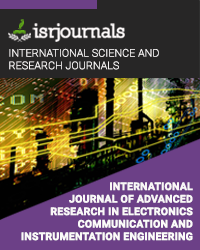use of nanotechnology and relay switches to treat glaucoma
NANDHINI.M,
Published in International Journal of Advanced Research in Electronics, Communication & Instrumentation Engineering and Development
ISSN: 2347 -7210 Impact Factor:1.9 Volume:1 Issue:1 Year: 08 November,2013 Pages:12-22

Abstract
Vision is so important in one’s life. But it is likely to be lost by various diseases. One such disease is called glaucoma. If the intraocular pressure in the eye exceeds 10-20 mm of hg, it may result in glaucoma. The front part of the eye is filled with a clear fluid called intraocular fluid or aqueous humor made by the ciliary body. The fluid flows out through the canal of schelmm whose diameter is of micrometer range. It is then absorbed into the blood stream through the eye’s drainage system. The inner pressure of the eye (intraocular pressure or IOP) depends upon the amount of fluid in the eye. In glaucoma, the drainage system remains open or closed causing the IOP to increase or decrease. The purpose of this paper is to overcome this disorder.a nanosensor is implanted in the eyes. A micro sized relay switch is placed at the opening of the canal of schelmm. The pressure in the eyes is detected by the nanosensor. If the pressure of the aqueous fluid exceeds 20 mm of hg, the relay switch is opened and the fluid is allowed to drain through the canal of schelmm. If the pressure is below 10mm of hg, the relay switch is closed, so that the fluid does not drain into the canal of schelmm. Thus the pressure is maintained constant. So the patient with glaucoma never loses his/her vision.
Kewords
The production, flow, and drainage
Reference
[1] Huan-Liang Tsai, Ci-Siang Tu, and Yi-Jie Su “Development of Generalized Photovoltaic Model Using MATLAB/SIMULINK” WCECS2008,October 2008. [2] E. Durán, M.B. Ferrera, J.M. Andújar, M.S. Mesa “I-V and P-V Curves Measuring System for PV Modules based on DC-DC Converters and Portable Graphical Environment” IEEE, 978-1-4244, 2011. [3] I. H. Altas , A.M. Sharaf “A Photovoltaic Array Simulation Model for Matlab-Simulink GUI Environment,” IEEE transaction on energy conversion, vol.11, no.4, 2007. [4] J. Surya Kumara, Ch.Sai Babu “Mathematical Modeling and Simulation of Photovoltaic Cell using Matlab-Simulink Environment,” International Journal of Electrical and Computer Engineering, vol.2, no,1, pp.26-34, February 2012. [5] M. G. Villalva, J. R. Gazoli and E. Ruppert F. “A Comprehensive Approach to Modeling and Simulation of Photovoltaic Array,” IEEE Transaction of Power Electronics, vol.25, no.5, pp.1198-1208, 2009. [6] B. Sree Manju, R.Ramaprabha and Dr.B.L.Mathur “Modelling and Control of Standalone Solar Photovoltaic Charging System,” ICETECT in 2011. [7] Athimulam Kalirasu and Subharensu Sekar Dash “Simulation of Closed Loop Controlled Boost Converter for Solar Installation,” SERBIAN JOURNAL OF ELECTRICAL ENGINEERING, Vol. 7, No. 1, May 2010, 121-130. [8] Ali Chermitti, Omar Boukli-Hacene and Samir Mouhadjer “Design of a Library of Components for Autonomous Photovoltaic System under Matlab/Simulink”, nternational Journal of Computer Applications (0975 – 8887), Volume 53– No.14, September 2012. [9] F. Liu, S. Duan, B. Liu, Y. Kang “A Variable Size Incremental Conductance method for PV systems,” IEEE Transaction on Industrial Electronics, vol.55, no.7 pp.2622-2628,2008. [10] Nicola Femia, Giovanni Petrone, Giovanni Spagnuolo and Massimo Vitelli “Optimization of Perturb and Observe Maximum Power point Tracking Method,” IEEE transaction on power electronics, vol.20, no.4, July 2005. [11] Jae Ho Lee, HyunSu Bae and Bo Hyung Cho “Advanced Incremental Conductance MPPT Algorithm with a Veriable Step Size,” EPE-PEMC 2006. 8 [12] Hairul Nissah Zainudin Saad Mekhilef “Comparison Study of Maximum Power Point Tracker Techniques for PV Systems” 14th International Middle East Power Systems Conference (MEPCON’10), Cairo University, Egypt, December 19-21, 2010, Paper ID 278. [13] Trishan Esram and Patrick L. chapman “Comparison of Photovoltaic Array Maximum Power Point Tracking Techniques,” IEEE Transaction on power electronics, vol.22, no.2, June 2007. [14] M. Calavia, J.M. Perié, J.F. Sanz and J. Sallán “Comparison of MPPT strategies for solar modules,” International Conference on Renewable Energies and Power Quality (ICREPQ’10) [15] Azadeh Safari and Saad Mekhilef “Simulation and Hardware Implementation of Incremental Conductance MPPT with Direct Control Method Using Cuk Converter”, IEEE Transaction on Industrial Electronics, Vol.58, no.4, April 2011. [16] Emil Jimenez-Brea, Andres Salazar-Llinas, Eduardo Ortiz-Rivera and Jesus Gonzalez-Llorente “A Maximum Power Point Tracker Implementation for Photovoltaic Cells Using Dynamic Optimal Voltage Tracking” [17] Zameer Ahmad and S.N. Singh “Extraction of the Internal Parameters of Solar photovoltaic Module by developing Matlab / Simulink Based Model”, International Journal of Applied Engineering Research, ISSN 0973-4562 Vol.7 No.11 (2012). [18] Pandiarajan.N and Dr. Ranganath Muthu “Development of Power Electronic Circuit Oriented Model of Photovoltaic Module”, International Journal of Advanced Engineering Technology, E-ISSN 0976- 3945 Vol.II/ Issue IV/October-December, 2011/118- 127. [19] Ankur Bhattacharjee “Design and Comparative Study of Three Photovoltaic Battery Charge Control Algorithms in MATLAB/SIMULINK Environment”, International Journal of Advanced Computer Research (ISSN (print): 2249-7277 ISSN (online): 2277-7970), Volume-2 Number-3 Issue-5 September-2012. [20] Book “power electronics converters, applications and design,” third edition, by Mohammad H. Rashid. [21] Book “Fundamentals of Power Electronics,” second edition, by Robert W. Erickson and Dragan Maksimovic, University of Colorado, Boulder, Colorado.

